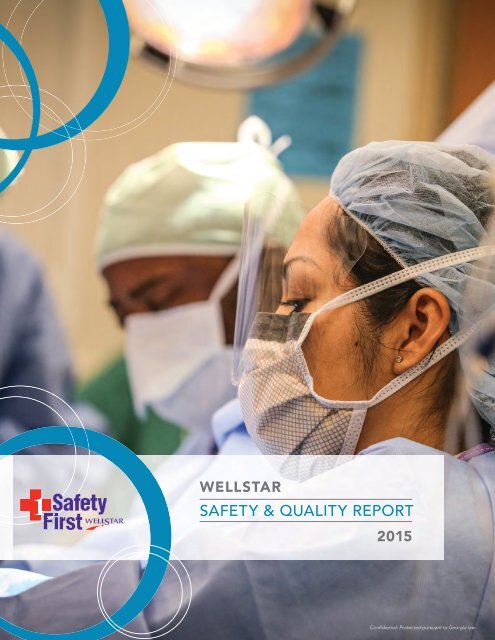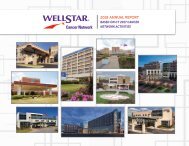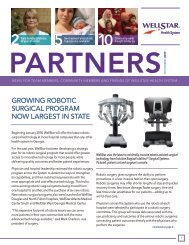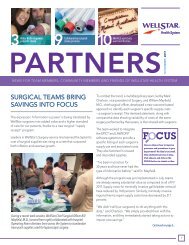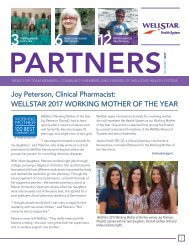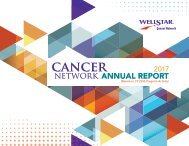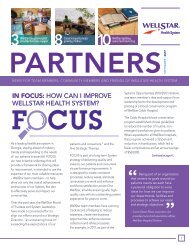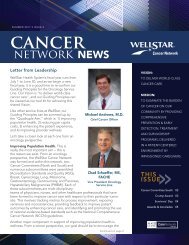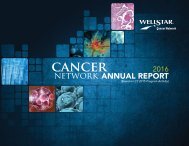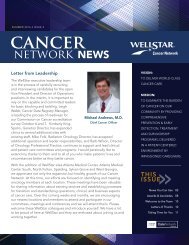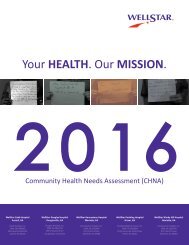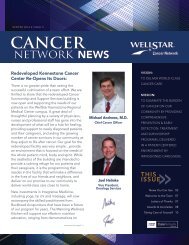WellStar 2015 Safety & Quality Report
You also want an ePaper? Increase the reach of your titles
YUMPU automatically turns print PDFs into web optimized ePapers that Google loves.
WELLSTAR<br />
SAFETY & QUALITY REPORT<br />
<strong>2015</strong><br />
Confidential: Protected pursuant to Georgia law
SAFETY<br />
QUALITY REPORT&MESSAGE<br />
We are pleased to share with you <strong>WellStar</strong> Health System’s <strong>2015</strong> Annual <strong>Quality</strong><br />
<strong>Report</strong>. This was an exciting year of progress at <strong>WellStar</strong>! As a dynamic, progressive<br />
healthcare System, <strong>WellStar</strong>’s team members continued to develop a high reliability<br />
culture, improve processes to remove waste and decrease variation (the enemy<br />
of quality!), and create the highest quality experience for our patients and our<br />
community. Several new leaders have joined <strong>WellStar</strong>’s team and many more have<br />
leveraged their Lean Six Sigma training to complete important quality projects.<br />
And, we have invested in a strategic quality transformation to achieve higher levels<br />
of performance in patient care and organizational effectiveness.<br />
The synergy from working together as a team, focusing on metrics that matter, and<br />
exemplifying our mission of world-class patient-centered care, is clearly reflected<br />
in <strong>WellStar</strong>’s accolades for safety and quality from national organizations. While we<br />
celebrate these successes, we remain driven to achieve zero harm, patient experience<br />
that exceeds expectations, and identify opportunities to improve, implement best<br />
practices, and provide the best outcomes for the individuals and communities we serve.<br />
<strong>WellStar</strong> is fortunate to have visionary leaders fully committed to quality and safety,<br />
including our Board of Directors, System and hospital executives, medical staff and<br />
service line leaders, System and hospital administration. Their inspiration, support<br />
and encouragement help to keep us focused on our goals.<br />
I am excited by the many accomplishments we achieved in <strong>2015</strong> along our journey<br />
to high reliability and world-class healthcare. This report reflects the enormous<br />
efforts of each of you who role model <strong>WellStar</strong>’s mission and vision every day.<br />
Sincerely,<br />
BOB LUBITZ<br />
ROBERT LUBITZ, M.D., MPH, MACP<br />
System Lead, <strong>Quality</strong> and <strong>Safety</strong><br />
<strong>WellStar</strong> Health System
TABLE OF CONTENTS<br />
Executive Summary . . . . . . . . . . . . 1<br />
System <strong>Safety</strong> and<br />
<strong>Quality</strong> Goal Achievement . . . . . . 2<br />
Patient Experience . . . . . . . . . . . . 10<br />
Performance Improvement . . . . . 10<br />
Regulatory Visits –<br />
Fiscal Year <strong>2015</strong> . . . . . . . . . . . . . . . 11<br />
<strong>Safety</strong> First. . . . . . . . . . . . . . . . . . . 12<br />
<strong>Quality</strong> Transformation . . . . . . . . 12<br />
Medication <strong>Safety</strong> . . . . . . . . . . . . 13<br />
<strong>WellStar</strong> <strong>Safety</strong> and<br />
<strong>Quality</strong> Recognitions . . . . . . . . . . 14<br />
EXECUTIVE SUMMARY<br />
In this past fiscal year, <strong>WellStar</strong> continued our commitment to improve<br />
quality and patient safety by establishing System goals to reduce<br />
incidences of preventable patient harm, hospital-associated infections<br />
(HAIs) and readmissions.<br />
For FY <strong>2015</strong>, <strong>WellStar</strong> established goals and targets to reduce:<br />
(1) Patient safety indicators (PSIs) by 10 percent to a rate less than 3.7.<br />
(2) Overall HAIs by 10 percent to a rate less than 8.8.<br />
(3) Readmissions by 10 percent for select diagnoses to a rate less<br />
than 14.5.<br />
SAFETY AND QUALITY ANNUAL REPORT I <strong>2015</strong> I 1
SYSTEM SAFETY AND QUALITY<br />
GOAL ACHIEVEMENT<br />
IMPROVEMENT ACTIONS<br />
AND NEXT STEPS:<br />
<strong>WellStar</strong> initiated a number of<br />
improvement activities to address<br />
PSI performance, including:<br />
> Development and dissemination<br />
of PSI documentation cards and<br />
provider education regarding<br />
respiratory failure versus<br />
respiratory insufficiency and<br />
obstetrical lacerations. We are<br />
working on similar educational<br />
cards for accidental punctures<br />
and lacerations as well as coding<br />
education for providers related<br />
to ICD-10.<br />
> Development and implementation<br />
of a nurse-driven deep vein<br />
thrombosis (DVT) protocol and<br />
revision of the DVT/pulmonary<br />
embolism workflow in Epic.<br />
> Development of PSI audit<br />
screens and record reviews<br />
focusing on select indicators for<br />
identification of trends.<br />
> Facility assessment of Clear<br />
Lungs activities and evaluation<br />
of a nurse-driven protocol for<br />
incentive spirometry. Clear Lungs<br />
is a proven respiratory program<br />
designed at <strong>WellStar</strong> to prevent<br />
lung or pulmonary complications<br />
through coughing, learning,<br />
exercising, activities and oral<br />
rinsing/brushing (CLEAR).<br />
> Implementation of a<br />
collaborative process between<br />
quality, clinical documentation<br />
and coding for review and<br />
determination of case status.<br />
GOAL 1 | PATIENT SAFETY INDICATORS<br />
<strong>WellStar</strong> PSI<br />
Events per 100 discharges<br />
4.0<br />
3.5<br />
3.0<br />
2.5<br />
2.0<br />
1.5<br />
1.0<br />
0.5<br />
0<br />
3.2<br />
2.5<br />
3.0<br />
2.8<br />
2.6<br />
3.0<br />
April May June July August Sept Oct Nov Dec Jan Feb Mar<br />
2014 2014 2014 2014 2014 2014 2014 2014 2014 <strong>2015</strong> <strong>2015</strong> <strong>2015</strong><br />
2.8<br />
3.1<br />
Target: 3.7<br />
PSI Rate/100<br />
Trendline<br />
3.2<br />
3.1<br />
2.7<br />
2.7<br />
Results: <strong>WellStar</strong> achieved a FY 15 rate of 2.9 against the target of 3.7 or less with all facilities exceeding established<br />
target, reducing PSIs by 142 cases from the previous year.<br />
2 I <strong>2015</strong> I SAFETY AND QUALITY ANNUAL REPORT
GOAL 2 | HOSPITAL-ASSOCIATED INFECTIONS<br />
<strong>WellStar</strong> HAI<br />
Rates per 1000 discharges<br />
10<br />
9<br />
8<br />
7<br />
6<br />
5<br />
4<br />
3<br />
2<br />
1<br />
0<br />
8.4<br />
5.8<br />
8.6<br />
7.2<br />
8.9<br />
9.5<br />
July August Sept Oct Nov Dec Jan Feb Mar April May June<br />
2014 2014 2014 2014 2014 2014 <strong>2015</strong> <strong>2015</strong> <strong>2015</strong> <strong>2015</strong> <strong>2015</strong> <strong>2015</strong><br />
6.8<br />
7.1<br />
Target: 8.8<br />
HAI Rate/1000<br />
Trendline<br />
6.8<br />
6.1<br />
6.8<br />
5.0<br />
Results: <strong>WellStar</strong> achieved a FY 15 rate of 7.2 against the target of 8.8 or less with four of five facilities exceeding<br />
established target; the remaining facility achieved a negative variance of only 0.44. There were 152 fewer cases<br />
this fiscal year than in the previous period.<br />
IMPROVEMENT ACTIONS<br />
AND NEXT STEPS:<br />
<strong>WellStar</strong> has initiated a number of<br />
improvement activities to address<br />
HAIs, including:<br />
> Continued Xenex usage in<br />
isolation rooms with revisions<br />
to schedule as well as training<br />
of additional staff to maximize<br />
areas and cycles.<br />
> Urinary catheter care competencies<br />
created for nursing personnel.<br />
> Isolation compliance surveillance<br />
and feedback.<br />
> Evaluation of daily urinary<br />
catheter and central line device<br />
necessity in daily rounding and<br />
patient assessments.<br />
> Implementation of a new Foley<br />
urinary catheter care kit with<br />
more intuitive packaging to<br />
prompt best practice insertion<br />
techniques.<br />
> Standardization of urinary Foley<br />
care across the System and<br />
implementation of nurse-driven<br />
Foley protocol.<br />
> Covering central lines during<br />
patient transport.<br />
> Development of A Team<br />
Approach to Reduction of<br />
Surgical Site Infections (SSIs);<br />
through the project, Cobb’s<br />
multidisciplinary SSI team<br />
dramatically decreased the<br />
rate of SSIs, specifically in<br />
hysterectomies and colon<br />
surgeries.<br />
> Reinforcement of hand hygiene<br />
through a designed safety<br />
coach /secret shopper activity<br />
across the System.<br />
> Implementation of stethoscope<br />
cleaning stations during National<br />
Patient <strong>Safety</strong> Week with<br />
concurrent provider education.<br />
> Increased awareness of hand<br />
hygiene importance through<br />
distribution of personal hand<br />
sanitizers to team members,<br />
patients, families and visitors during<br />
National Patient <strong>Safety</strong> Week.<br />
> Created Epic-generated reports<br />
to identify patients with lines,<br />
drains and airway devices to serve<br />
as a daily prompt to the care team<br />
for ongoing assessment.<br />
I <strong>2015</strong> I SAFETY AND QUALITY ANNUAL REPORT I 3
GOAL 3 | READMISSIONS<br />
Select patient population includes: Age 65 or older, Chronic Obstructive Pulmonary Disease (COPD), Stroke,<br />
Pneumonia, Heart Failure, Acute Myocardial Infarction (MI), Isolated Coronary Artery Bypass Grafting (CABG),<br />
and Total Knee Arthroplasty/Total Hip Arthroplasty for all patients readmitted to the same facility.<br />
GOAL #3: REDUCE READMISSIONS FOR SELECT DIAGNOSES (FY <strong>2015</strong>)<br />
Facility FY 14 FY 15 Target<br />
CH 14.5% 13.4% 13.9%<br />
DH 15.1% 10.9% 14.5%<br />
KH 16.1% 13.1% 15.5%<br />
PH 10.5% 8.4% 10.1%<br />
WMG 15.1% 12.5% 14.5%<br />
System 15.1% 12.5% 14.5%<br />
Results: <strong>WellStar</strong> achieved a FY 15 rate of 12.5 against the target of 14.5 or less with all facilities exceeding<br />
established target.<br />
IMPROVEMENT ACTIONS<br />
AND NEXT STEPS:<br />
<strong>WellStar</strong> initiated a number of<br />
improvement activities to address<br />
readmissions, including:<br />
> Creation of a readmission work<br />
group to address discharge and<br />
post-discharge opportunities.<br />
> Readmission Task Force and<br />
Performance Improvement<br />
Committees to review outliers<br />
and adverse patterns.<br />
> Creation of the Heart Failure<br />
Academy in conjunction with<br />
Cardiovascular Medicine<br />
Douglasville office.<br />
> Development of individualized<br />
care plans for patients with<br />
frequent admissions.<br />
> Provision of 30-day supply of<br />
medications for patients with<br />
heart failure.<br />
> Placement of Population Health<br />
Case Managers for Accountable<br />
Care Organizations (ACO) patient<br />
population:<br />
– Embedded in Primary Care<br />
Physician (PCP) offices and one<br />
Pulmonary Specialist Practice<br />
– Telephonic Case Managers<br />
> Hospitalist Care Coaches at Cobb,<br />
Douglas and Kennestone working<br />
with high-risk patient populations<br />
face-to-face prior to discharge.<br />
Direct hand-off to Population<br />
Health Case Managers in the<br />
outpatient (OP) setting.<br />
> Development of COPD taskforce<br />
to standardize care for the COPD<br />
patient population.<br />
> Initiatives to increase the volume<br />
of post-discharge follow-up visits<br />
with a physician. Daily discharge<br />
list being sent to each PCP<br />
practice. Practices are tasked with<br />
reaching out to their patients and<br />
scheduling the follow-up<br />
appointments.<br />
> Skilled Nursing Facility (SNF)<br />
collaborative. Monthly meetings<br />
with community SNFs to share<br />
data on readmissions and other<br />
quality indicators and participate<br />
in joint action planning.<br />
4 I <strong>2015</strong> I SAFETY AND QUALITY ANNUAL REPORT
<strong>WellStar</strong>’s team members continue to develop a high<br />
reliability culture, improve processes to remove waste and<br />
decrease variation.
We have invested in a strategic quality transformation to achieve higher<br />
levels of performance in patient care and organizational effectiveness.<br />
POPULATION HEALTH MANAGEMENT |<br />
READMISSION ANALYSIS<br />
> Population Health Case management reviewed and<br />
tracked 837 patients<br />
– A routine analysis is conducted by each OP case<br />
manager for every patient readmitted<br />
> Most readmissions occur within three days of<br />
discharge for patients with relatively short index<br />
admission lengths of stay<br />
> Approximately 45 percent of readmissions occur<br />
within the first week of index discharge<br />
> 17 percent of readmissions are sent back to the<br />
hospital from their PCP practice<br />
> 11 percent of readmissions are scheduled admissions<br />
(elective)<br />
> Although the patient may have been on the<br />
appropriate treatment and still required some medical<br />
intervention or support, care potentially could have<br />
been provided in a different care setting or by<br />
changing the treatment plan in the OP setting<br />
6 I <strong>2015</strong> I SAFETY AND QUALITY ANNUAL REPORT
TOP REASONS FOR READMISSION<br />
Reason # %<br />
Failed OP treatment 354 42%<br />
New diagnosis - unrelated 244 29%<br />
Vital Signs or Mental Status<br />
Changes<br />
INDEX ADMISSIONS LOS<br />
50 6%<br />
New infection 35 4%<br />
Function/Mobility Changes 32 4%<br />
End-of-life diagnosis/<br />
prognosis<br />
31 4%<br />
Recurrent infection 28 3%<br />
Non-adherent - By choice 16 2%<br />
Medications not taken as<br />
prescribed<br />
Medication-related<br />
complication<br />
15 2%<br />
9 1%<br />
All others 23 3%<br />
Total 837 –<br />
Days # %<br />
0-1 63 8%<br />
REFERRAL SOURCE FOR READMISSION<br />
Source # %<br />
Self/family direction 636 76%<br />
Sent to hospital by/<br />
from Dialysis<br />
Sent to hospital by/<br />
from Home Health or<br />
Hospice<br />
Sent to hospital by/<br />
from MD office<br />
Sent to hospital<br />
by/from Subacute<br />
Rehab/Skilled Nursing<br />
Facility/Long-Term<br />
Acute Care<br />
15 2%<br />
13 2%<br />
142 17%<br />
31 4%<br />
Total 837 101%*<br />
* Percentage greater than 100 due to rounding<br />
ELECTIVE ADMISSION<br />
# %<br />
Yes 91 11%<br />
No 746 89%<br />
Total 837 –<br />
2-5 473 57%<br />
5-10 304 36%<br />
10-15 83 10%<br />
15-25 43 5%<br />
25-50 10 1%<br />
DAYS BETWEEN READMISSIONS (0-30)<br />
Days # %<br />
0-3 154 18%<br />
4-6 113 14%<br />
7-9 108 13%<br />
10-12 90 11%<br />
13-15 92 11%<br />
16-18 85 10%<br />
19-21 66 8%<br />
22-24 48 6%<br />
25-27 51 6%<br />
28-30 30 4%<br />
Total 837 –<br />
The synergy from working together as a team, focusing on metrics that matter, and<br />
exemplifying our mission of world-class patient-centered care, is clearly reflected in<br />
our accolades for safety and quality from national organizations.<br />
I <strong>2015</strong> I SAFETY AND QUALITY ANNUAL REPORT I 7
WINDY HILL HOSPITAL<br />
WINDY HILL KEY MEASURE PERFORMANCE<br />
WH Key Measure Performance for Goal FY 14 (Apr-June) Key Measure Goal<br />
Beta Blocker Therapy Received (perioperative) Outpatient 100.00% 95%, 100%<br />
Falls with Injury per 1000 patient days 0.52 0.70, 0.61<br />
Nosocomial Pressure Ulcers per 1000 patient days 0.57 0.50, 0.25<br />
Pain Reassessment (%) 93.86% 97%, 100%<br />
Pneumovax Immunization Rate 96.38% 90%, 95%<br />
Ventilator Wean Rate 80.49% 80%, 90%<br />
Catheter-Associated Urinary Tract Infection (CaUTI) Rate<br />
(based upon 1000 device days; baseline rate 4.0)<br />
3.4 3.75, 3.50%<br />
Mammography Follow Up within 45 Days 100.00% 95%, 100%<br />
Total Goals Met<br />
Apr-11 points, May-11 points<br />
All measures are cumulative. FY 15 performance will be judged by a full fiscal year (July 2014-June <strong>2015</strong>)<br />
Results: <strong>WellStar</strong> Windy Hill Hospital met or exceeded six of eight key<br />
performance indicators: Beta Blocker Therapy, Falls with Injury, Immunization<br />
for Pneumovax, CaUTI, Mammograms and Ventilator Weaning.<br />
IMPROVEMENT ACTIONS AND NEXT STEPS:<br />
Though the ventilator-weaning rate exceeds national<br />
benchmarks, Windy Hill has established exceptional<br />
performance expectations for this indicator.<br />
In addition to the previously identified efforts<br />
to reduce PSIs and HAIs, Windy Hill initiated a<br />
number of improvement activities to address these<br />
performance indicators, including:<br />
> Pain reassessment audits and reinforcement of<br />
documentation in the electronic medical record<br />
> Revised screening tools and implementation of<br />
Best Practice Alerts for immunizations<br />
> Interdisciplinary rounds with the Skin and Wound<br />
Assessment Team for prevention of pressure ulcers<br />
> Falls prevention team for post-occurrence<br />
assessment and proactive action planning<br />
8 I <strong>2015</strong> I SAFETY AND QUALITY ANNUAL REPORT
We remain driven to achieve zero harm, patient experience that<br />
exceeds expectations, and identify opportunities to improve,<br />
implement best practices, and provide the best outcomes for<br />
the individuals and communities we serve.
PATIENT EXPERIENCE<br />
WELLSTAR HEALTH SYSTEM HCAHPS PATIENT EXPERIENCE DATA<br />
Fiscal Year 2016 To-Date with FFY 2017 Thresholds and Benchmarks<br />
November Response Rates (Natl. Avg. is 24.4% ) 15.7% 15.7% 19% 21.1%<br />
HCAHPS Pt.<br />
Experience Data<br />
Jul. 1 - Dec. 31 ,<br />
<strong>2015</strong><br />
Number of<br />
Surveys<br />
Rate hospital<br />
0-10<br />
FFY<br />
2017<br />
Threshold<br />
Est.<br />
CMS<br />
60th<br />
%tile<br />
FFY 2017<br />
Benchmark<br />
(90th<br />
%tile)<br />
Cobb<br />
(goal = 8/8 at<br />
Threshold)<br />
Douglas<br />
(goal = 8/8 at<br />
Threshold)<br />
Kennestone<br />
(goal = 4/8<br />
Threshold, 4/8<br />
60th %tile)<br />
Paulding<br />
(goal = 4/8<br />
Threshold, 4/8<br />
60th %tile)<br />
System<br />
(goal = 6/8<br />
Threshold, 2/8<br />
60th %tile)<br />
1147 VTT* 360 VTT* 2193 VTT* 518 VTT* 4218 VTT*<br />
Top Box Percentage (plus and minus represent change from last month)<br />
70.0 73.7 84.6 69.0 = -1.0 71.7 1.7 71.3 + 1.3 77.2 + 7.2 71.4 = 1.4<br />
<strong>WellStar</strong> / <strong>Safety</strong> First Program<br />
Comm w/ Nurses 78.2 80.3 86.6 75.5 -2.7 79.6 1.4 78.2 + 0.0 80.1 + 1.9 77.8 -0.4<br />
Response of<br />
Hosp Staff<br />
Comm w/<br />
Doctors<br />
Hospital<br />
Environment<br />
Pain<br />
Management<br />
Comm About<br />
Medicines<br />
Discharge<br />
Information<br />
Recommend the<br />
hospital<br />
Care Transitions<br />
(mean score)<br />
65.1 68.8 80.0 63.9 -1.2 68.7 3.6 66.4 = 1.3 66.1 + 1.0 65.9 0.8<br />
80.5 82.6 88.8 81.6 1.1 76.9 -3.6 81.3 + 0.8 77.7 + -2.8 80.6 + 0.1<br />
65.3 68.8 79.4 67.2 = 1.9 69.8 + 4.5 67.5 + 2.2 75.5 + 10.2 68.6 + 3.3<br />
70.3 72.3 78.3 70.5 0.2 71.3 = 1.0 72.4 + 2.1 70.7 + 0.4 71.6 + 1.3<br />
62.9 65.5 73.4 61.0 -1.9 63.8 0.9 64.7 + 1.8 66.3 + 3.4 63.8 + 0.9<br />
85.9 87.2 91.2 85.2 + -0.7 86.0 = 0.1 85.8 = -0.1 86.4 + 0.5 85.7 = -0.2<br />
Not a Part of Goals or VBP<br />
73.5 76.3 84.8 68.7 -4.8 70.4 + -3.1 75.8 + 2.3 78.7 = 5.2 73.8 = 0.3<br />
81.6 82.5 85.3 81.1 -0.5 82.7 + 1.1 82.0 + 0.4 83.1 + 1.5 81.9 + 0.3<br />
Gap Index -9.6 7.6 12.1 28.5 7.8<br />
*Variance-to-Threshold<br />
Results: Eight of ten indicators for <strong>WellStar</strong> exceed threshold and the remaining indicators are within 1 to 2 points<br />
of target. Each facility has an established patient experience team that serves as an internal resource to department<br />
and unit efforts. Kennestone leads the patient experience efforts and serves as a resource to all sites, sharing<br />
established practices.<br />
PERFORMANCE IMPROVEMENT<br />
<strong>WellStar</strong> leadership set expectation<br />
for Lean Six Sigma training for all<br />
managers and above in order to<br />
provide a foundation for consistent<br />
process improvement (PI) methodology<br />
and efforts. As of June <strong>2015</strong>,<br />
997 <strong>WellStar</strong> leaders had completed<br />
training. In addition, from the<br />
training, 172 yellow and green belt<br />
performance improvement projects<br />
have been completed. Through<br />
increased executive sponsor<br />
engagement throughout the year<br />
as well as selection of improvement<br />
projects from different areas of the<br />
organization, including Human<br />
Resources, Clinical, Information<br />
Technology, Finance, Marketing,<br />
Operations, and social media,<br />
<strong>WellStar</strong> achieved the following:<br />
> $8.6 million in cost savings<br />
> $2.1 million in revenue generation<br />
> $1.7 million in soft savings<br />
10 I <strong>2015</strong> I SAFETY AND QUALITY ANNUAL REPORT
REGULATORY VISITS-FISCAL YEAR <strong>2015</strong><br />
JULY 2014<br />
> Home Care – Joint Commission<br />
Accreditation<br />
AUGUST 2014<br />
> Douglas Hospital – Centers for<br />
Medicare and Medicaid Services<br />
Validation Survey<br />
> Kennestone Hospital – Food and<br />
Drug Administration (FDA)<br />
Biannual Survey of the Blood Bank<br />
SEPTEMBER 2014<br />
> Windy Hill Hospital – Joint<br />
Commission Accreditation<br />
> Paulding Hospital – Joint<br />
Commission Accreditation<br />
OCTOBER 2014<br />
> Paulding Hospital – Joint<br />
Commission Accreditation<br />
> Paulding Hospital – Inpatient<br />
Advanced Diabetes Recertification<br />
NOVEMBER 2014<br />
> Kennestone Hospital – Joint<br />
Commission Disease-Specific<br />
Certification (DSC) – Total<br />
Joint Program (Hip and Knee)<br />
Recertification<br />
> Douglas Hospital – Joint<br />
Commission Accreditation<br />
DECEMBER 2014<br />
> Cobb Hospital – Joint<br />
Commission Accreditation<br />
JANUARY <strong>2015</strong><br />
> Kennestone Hospital – Joint<br />
Commission- Lab Accreditation<br />
> Kennestone Hospital – Joint<br />
Commission DSC – Heart Failure<br />
Recertification<br />
> Kennestone Hospital – Joint<br />
Commission DSC – CABG and<br />
Valve Recertification<br />
> Kennestone Hospital – American<br />
Association of Blood Banks and<br />
College of American Pathologists<br />
(CAP) – Blood Bank Semi-Annual<br />
Survey<br />
FEBRUARY <strong>2015</strong><br />
> Kennestone Hospital – CAP<br />
– Main Lab<br />
> Kennestone Hospital – Joint<br />
Commission – DSC<br />
Comprehensive Stroke Survey<br />
> Douglas Hospital – CAP Survey<br />
for Lab<br />
> Douglas Hospital – FDA<br />
Mammography<br />
MARCH <strong>2015</strong><br />
> Windy Hill Hospital – Joint<br />
Commission DSC-Respiratory<br />
Failure Program<br />
> Douglas Hospital – Joint<br />
Commission Unannounced<br />
Extension Survey for ICU<br />
APRIL <strong>2015</strong><br />
> Kennestone Hospital – Pediatric<br />
Center Barrett Parkway Joint<br />
Commission<br />
> Windy Hill Hospital – DSC-<br />
Respiratory Failure Accreditation<br />
MAY <strong>2015</strong><br />
> Kennestone Hospital –<br />
Occupational <strong>Safety</strong> and Health<br />
Administration Unannounced<br />
Survey Main Lab<br />
> Kennestone Hospital – FDA<br />
Mammography Inspection- Town<br />
Lake Imaging<br />
JUNE <strong>2015</strong><br />
> Kennestone Hospital – FDA<br />
Recall Follow-up Inspection –<br />
CareFusion Avea Ventilator<br />
Product #AHY 03116, AKV 01165<br />
and BAV 04700<br />
> Kennestone Hospital – Georgia<br />
Department of Natural Resources<br />
– Nuclear Medicine<br />
– Radiation Oncology<br />
> Kennestone Hospital – National<br />
Accreditation Program for Breast<br />
Cancer<br />
> Cobb County Detention<br />
Center – National Commission<br />
on Correctional Health<br />
Care – Accreditation with<br />
Commendation<br />
> Windy Hill Hospital – East Cobb<br />
Health Park State Inspection<br />
Outpatient Surgery Center<br />
JULY <strong>2015</strong><br />
> Kennestone Hospital –<br />
Bariatric Program Metabolic<br />
and Bariatric Surgery<br />
Accreditation and <strong>Quality</strong><br />
Improvement Program<br />
> Kennestone Hospital –<br />
FDA– Women’s Imaging-<br />
Mammography <strong>Quality</strong><br />
Standards Act Facility Inspection<br />
AUGUST <strong>2015</strong><br />
> Douglas Hospital – Nuclear<br />
Medicine Georgia Department<br />
of Natural Resources<br />
I <strong>2015</strong> I SAFETY AND QUALITY ANNUAL REPORT I 11
SAFETY FIRST<br />
QUALITY<br />
TRANSFORMATION<br />
The <strong>Safety</strong> First program continues to be transformational as we<br />
strive to develop a High Reliability Organization through our safety<br />
culture work. As of December <strong>2015</strong>, our Serious <strong>Safety</strong> Event Rate<br />
has decreased by 52 percent since 2008. In 2014, we focused on<br />
error reporting and cause analysis training resulting in improved<br />
error reporting rates and increased volume of cause analysis for<br />
precursor and near miss events. <strong>WellStar</strong> also implemented additional<br />
high reliability training for all members of leadership to reinforce<br />
expectations, behaviors and techniques to drive preventable harm<br />
events to zero. Facility safety huddles were implemented across the<br />
System in early 2014 and have expanded to unit and department<br />
levels, second shifts and weekends. These huddles allow team<br />
members to convey concerns from the past 24 hours and work<br />
toward resolution as well as proactively identify potential concerns<br />
or needs for the next 24 hours. In addition, during these huddles,<br />
individuals and teams can be publicly acknowledged as “safety stars”<br />
for exhibiting safety behaviors and using error prevention techniques<br />
that contribute to reducing or avoiding harmful situations further<br />
reinforcing <strong>WellStar</strong>’s expectation of making every day a safe day.<br />
<strong>WellStar</strong> administered the Agency for Healthcare <strong>Quality</strong> Culture of<br />
<strong>Safety</strong> Survey in March <strong>2015</strong> as a way to evaluate organizational<br />
culture of safety. Over 50 percent of <strong>WellStar</strong> team members completed<br />
the survey. Of those responding, over 70 percent rated <strong>WellStar</strong> as very<br />
good or excellent in providing<br />
patient safety. In addition, several<br />
narrative responses were very<br />
complimentary of hospital<br />
leadership in their safety efforts.<br />
Leadership recognized that our scope<br />
of improvement, rate of improvement<br />
and process reliability must accelerate<br />
in order for us to achieve and sustain<br />
our overarching 2020 goal of being<br />
a top decile performer. Leadership<br />
engaged expertise from Chartis Group<br />
to assist us in completing a gap analysis<br />
of our current and desired state. From<br />
our gap analysis, <strong>WellStar</strong> created a<br />
strategic plan with tactics and key<br />
tasks to:<br />
1. Strengthen governance and<br />
management oversight<br />
2. Refine quality organization structures<br />
3. Create “next generation” quality<br />
improvement systems and processes<br />
and<br />
4. Establish an enduring culture<br />
of quality and patient safety<br />
To strengthen governance and<br />
management oversight, we created<br />
a quality transformation steering<br />
committee. Key organizational leaders<br />
were selected and oversee our quality<br />
and safety priorities by focusing<br />
resources on targeted improvement<br />
efforts which are communicated and<br />
implemented throughout our System.<br />
We established standardized process<br />
improvement tools and reports using<br />
a combination of Lean and Six Sigma<br />
methodology and are refining our<br />
structures to support our robust efforts.<br />
<strong>WellStar</strong> has embraced our<br />
opportunities and we are committed<br />
to make the changes needed to<br />
transform our existing quality program<br />
into a leading quality program<br />
supportive of achieving our vision.<br />
12 I <strong>2015</strong> I SAFETY AND QUALITY ANNUAL REPORT
MEDICATION SAFETY<br />
The System medication reconciliation committee implemented various<br />
safety initiatives, including multiple changes to <strong>WellStar</strong> Connect to<br />
enhance ease of use and give providers information on their medication<br />
reconciliation efforts. Dialogue between providers and the committee<br />
resulted in <strong>WellStar</strong> Connect functionality changes.<br />
During <strong>2015</strong>, <strong>WellStar</strong> created and implemented the Medication History<br />
Specialist program, overseen by a pharmacist. These specialists are<br />
pharmacy technicians in the Emergency Departments who collect patient<br />
medication histories to aid in medication reconciliation.<br />
In addition, medication error and adverse drug reporting was transferred<br />
to our existing online incident reporting system beginning in January <strong>2015</strong><br />
so all incidents could be reported in the same system.<br />
Multiple Systemwide performance improvement projects were initiated<br />
in the pharmacies, including a process to administer nimodipine via oral<br />
syringes, neuromuscular blocker segregation and a process to manage<br />
concentrated human insulin (Humulin R U500).<br />
The 2014-15 Institute of Safe Medication Practices targeted medication<br />
safety best practices were addressed via facility medication use system<br />
improvement committees as well as the newly implemented pharmacy<br />
medication safety liaisons. The liaisons assist in operationalizing medication<br />
safety initiatives and perform quarterly proactive risk assessments via the<br />
ISMP quarterly action agenda.<br />
In FY <strong>2015</strong>, there were 152 fewer<br />
cases of HAIs than in the previous<br />
year. Four of five facilities exceeded<br />
the established target; the remaining<br />
facility achieved a negative variance<br />
of only 0.44.<br />
Our medication use policy subcommittee, chaired by our medication<br />
safety officer (MSO), facilitated review and update of policies to ensure they<br />
reflect best practice and meet regulatory standards. Our MSO presented<br />
nationally at Epic’s user group meeting and the midyear clinical meeting of<br />
the American Society of Health-System Pharmacists.<br />
The connect order set maintenance committee, an interdisciplinary team,<br />
assumed responsibility for governance over development and approval<br />
of all <strong>WellStar</strong> Connect electronic health record order sets for Systemwide<br />
deployment, based on clinical evidence of safety, efficacy and cost<br />
effectiveness. Multiple order sets and best practice alerts (BPAs) were<br />
created and revised. The team also addressed BPA fatigue, reducing alerts<br />
by over 50 percent.<br />
Another major initiative in <strong>2015</strong> included our new infusion pump technology<br />
acquisition process and subsequent implementation planning. This<br />
involved several months of coordination between nursing and pharmacy to<br />
create and build the new drug library and to identify and resolve practice<br />
discrepancies to ensure standardization and a successful and safe go-live.<br />
I <strong>2015</strong> I SAFETY AND QUALITY ANNUAL REPORT I 13
WELLSTAR SAFETY AND QUALITY RECOGNITIONS<br />
WELLSTAR CONTINUES TO RECEIVE STATE, REGIONAL, NATIONAL AND<br />
INTERNATIONAL RECOGNITION FOR SAFETY AND QUALITY IMPROVEMENTS.<br />
SYSTEM<br />
> <strong>WellStar</strong> was recognized by VHA<br />
National through VHA’s Leading<br />
Practices Blueprinting process.<br />
Working with hospitals with<br />
recognized leading clinical<br />
practices, VHA Inc., developed<br />
an innovative methodology for<br />
generating and transferring<br />
knowledge using a visual story<br />
format that incorporates structural,<br />
process and contextual elements<br />
into a comprehensive knowledge<br />
transfer vehicle called a VHA<br />
Leading Practice Blueprint. VHA<br />
blueprinted both <strong>WellStar</strong>’s <strong>Safety</strong><br />
First Harm Reduction program and<br />
Blood Management Program.<br />
> Systems Society announced<br />
<strong>WellStar</strong> has achieved Stage 6<br />
on the Electronic Medical Records<br />
(EMR) Adoption Model SM . Of the<br />
more than 5,400 hospitals tracked<br />
by Healthcare Information and<br />
Management Systems in the<br />
United States, only 18 percent<br />
achieve this high-level of<br />
integration. Stage 6 represents<br />
a level of sophistication that only<br />
1,040 U.S. hospitals have reached<br />
to date.<br />
> <strong>WellStar</strong> received the American<br />
Cancer Society’s Excellence Award<br />
in Workplace Tobacco Control,<br />
commending its Systemwide,<br />
comprehensive tobacco control<br />
program for team members.<br />
<strong>WellStar</strong>, which went smoke-free<br />
in 2012, is the only health system<br />
in Georgia to receive the highest<br />
level of recognition.<br />
> <strong>WellStar</strong> Cancer Network was<br />
one of only four accredited<br />
cancer programs in Georgia to<br />
receive the 2013 Outstanding<br />
Achievement Award from the<br />
Commission on Cancer (CoC)<br />
of the American College of<br />
Surgeons. A select group of only<br />
74 accredited cancer programs<br />
throughout the nation received<br />
the award, representing<br />
approximately 14 percent of<br />
programs surveyed by the CoC.<br />
In addition, the <strong>WellStar</strong> Cancer<br />
Network was granted three-year<br />
accreditation with commendation<br />
from the CoC. <strong>WellStar</strong> received<br />
eight commendations and earned<br />
the highest possible achievement.<br />
To earn accreditation, a cancer<br />
program must meet or exceed<br />
34 CoC quality care standards,<br />
be evaluated every three years<br />
through a survey process and<br />
maintain levels of excellence in<br />
the delivery of comprehensive<br />
patient-centered care.<br />
> Annual Leapfrog Hospital Survey<br />
results showed that all <strong>WellStar</strong><br />
hospital safety scores improved.<br />
Only 17 Georgia hospitals received<br />
a grade of “A” and <strong>WellStar</strong><br />
Douglas and Paulding were among<br />
top performers. <strong>WellStar</strong> Cobb and<br />
Kennestone received a grade of<br />
“B.” Windy Hill Hospital is not<br />
rated by Leapfrog.<br />
14 I <strong>2015</strong> I SAFETY AND QUALITY ANNUAL REPORT
FACILITY<br />
At the 2014 Annual VHA Georgia Leadership Expo:<br />
– For Category 50-125 beds, <strong>WellStar</strong> Douglas Hospital won second and third place, respectively, for “Stabilization<br />
of the Sick Newborn” and “Surge Protection: Overcoming Throughput Barriers in the Hospital Macro System.”<br />
– For Category Greater than 350 Beds, <strong>WellStar</strong> Kennestone Hospital received second place for “COPD Care<br />
Management across the Continuum.”<br />
> <strong>WellStar</strong> Cobb Hospital continues<br />
to garner recognition for its<br />
impressive improvements in<br />
decreasing post-operative surgical<br />
site infection rates. Cobb recently<br />
received the Josh Nahum Special<br />
Achievement Award for Infection<br />
Prevention and Control at the<br />
Georgia Hospital Association’s<br />
annual Patient <strong>Safety</strong> Summit.<br />
The award was given to Cobb for<br />
its project, “A Team Approach to<br />
Reduction of Surgical Site<br />
Infections (SSIs).” Through the<br />
project, Cobb’s multidisciplinary<br />
SSI team dramatically decreased<br />
the rate of SSIs, specifically in<br />
hysterectomies and colon<br />
surgeries.<br />
> Cobb Hospital remains the only<br />
hospital in Georgia to receive<br />
“Meritorious” status for surgical<br />
patient outcomes from the<br />
American College of Surgeons<br />
and only one of 37 facilities<br />
worldwide, representing the top<br />
10 percent of participating<br />
hospitals. Meritorious distinction<br />
is awarded for quality composite<br />
scores in the outcomes for<br />
mortality, DVT or pulmonary<br />
embolism, cardiac incidents,<br />
respiratory (pneumonia),<br />
unplanned intubation, ventilator<br />
greater than 48 hours, renal<br />
failure, SSI and UTI.<br />
> Cobb was identified as the<br />
first and only General Surgery<br />
EpiCenter in Georgia and only<br />
one of 29 in the nation by<br />
DaVinci Surgical Systems.<br />
> Kennestone Hospital received<br />
Consumer <strong>Report</strong>s magazine’s<br />
highest ranking for CABG. It is<br />
the only hospital in Georgia, and<br />
one of only two in the U.S. to<br />
receive the disease-specific<br />
certification for coronary bypass<br />
surgery and valve replacement<br />
and repair from The Joint<br />
Commission. In addition this year,<br />
Kennestone received the top<br />
rating from the Society of<br />
Thoracic Surgeons for CABG.<br />
> Kennestone Hospital is one of<br />
only two Georgia hospitals on<br />
the Becker’s Hospital Review<br />
“100 Hospitals with Great<br />
Oncology Programs” list. This<br />
is the second consecutive year<br />
Becker’s has recognized<br />
Kennestone.<br />
> Paulding Hospital earned<br />
The Joint Commission’s Gold<br />
Seal of Approval for its<br />
inpatient diabetes care program.<br />
The inpatient diabetes<br />
certification program is based<br />
on the American Diabetes<br />
Association Clinical Practice<br />
recommendations.<br />
> Paulding Hospital was recognized<br />
as a 2013 Top Performer on Key<br />
<strong>Quality</strong> Measures ® by The Joint<br />
Commission. Paulding was<br />
recognized as part of The Joint<br />
Commission’s 2014 annual<br />
report, “America’s Hospitals:<br />
Improving <strong>Quality</strong> and <strong>Safety</strong>,”<br />
for attaining and sustaining<br />
excellence in accountability<br />
measure performance for<br />
pneumonia and surgical care.<br />
It is one of the 1,224 hospitals<br />
in the U.S. to achieve the Top<br />
Performer distinction and the<br />
second year Paulding has<br />
received the honor.<br />
I <strong>2015</strong> I SAFETY AND QUALITY ANNUAL REPORT I 15
<strong>WellStar</strong> Paulding Nursing and<br />
Rehabilitation Center received<br />
the highest possible overall rating<br />
of five stars in the U.S. News &<br />
World <strong>Report</strong>’s sixth annual Best<br />
Nursing Homes. This is the<br />
second year the center has<br />
achieved top recognition.<br />
> <strong>WellStar</strong> Kennestone received the<br />
<strong>2015</strong> Healthgrades Distinguished<br />
Hospitals for Clinical Excellence<br />
Award, recognizing it as a hospital<br />
performing in the top five percent<br />
nationally for overall clinical<br />
excellence. While many hospitals<br />
have specific areas of expertise<br />
and high-quality outcomes in<br />
one or two areas, hospitals<br />
awarded this distinction exhibit<br />
comprehensive high-quality care<br />
across all areas based on riskadjusted<br />
mortality and complication<br />
rates for a comprehensive set of<br />
procedures and conditions.<br />
> Additionally, Healthgrades named<br />
Kennestone Hospital one of<br />
America’s 100 Best Hospitals<br />
for Cardiac Care, Critical Care,<br />
Pulmonary Care and Stroke Care.<br />
<strong>WellStar</strong> Kennestone also received<br />
the <strong>2015</strong> Excellence Award for<br />
Gastrointestinal (GI) Care and<br />
Neurosciences. Finally, Kennestone<br />
received 11 Healthgrades “Five<br />
Star” ratings in the areas of Acute<br />
MI, Heart Failure, Pulmonary<br />
Embolism, Respiratory Failure,<br />
Sepsis, Esophageal/GI Surgery,<br />
GI Bleed, Small Intestinal Surgery,<br />
Stroke, COPD and Pneumonia.<br />
> <strong>WellStar</strong> Cobb Hospital received<br />
seven Healthgrades “Five Star”<br />
ratings in the areas of Heart Failure,<br />
Diabetes, Respiratory Failure,<br />
Esophageal/Stomach Surgery, GI<br />
Bleed, Stroke and Pneumonia.<br />
> <strong>WellStar</strong> Douglas Hospital<br />
received the <strong>2015</strong> Healthgrades<br />
Excellence Award for Pulmonary<br />
Care. In addition, Douglas<br />
received six Healthgrades “Five<br />
Star” ratings in the areas of Heart<br />
Failure, Pulmonary Embolism,<br />
Respiratory Failure, Sepsis,<br />
COPD and Pneumonia.<br />
> Paulding Hospital received<br />
Healthgrades “Five Star” rating<br />
for Respiratory Failure.<br />
> <strong>WellStar</strong> Medical Group Internal<br />
Medicine Associates of Marietta<br />
received Level 3 certification for<br />
Patient-Centered Medical Homes,<br />
the highest level of distinction<br />
from the National Committee for<br />
<strong>Quality</strong> Assurance (NCQA).<br />
> <strong>WellStar</strong> Medical Group Family<br />
Medicine at East Cobb received<br />
Level 2 certification for Patient-<br />
Centered Medical Homes from<br />
the NCQA.<br />
> <strong>WellStar</strong> Health Place ranked<br />
fourth in the Top 10 Fitness<br />
Centers recognized by the<br />
Atlanta Business Chronicle.<br />
> <strong>WellStar</strong> Cobb, Douglas,<br />
Kennestone and Paulding were<br />
recognized by Georgia Trend<br />
Magazine as Georgia Top<br />
Hospitals. Douglas ranked first in<br />
Top Small Hospitals (400 beds).<br />
16 I <strong>2015</strong> I SAFETY AND QUALITY ANNUAL REPORT
TEAM MEMBERS<br />
> Candice Saunders, <strong>WellStar</strong> president and chief operating officer, was<br />
named chair-elect of the Board of Trustees of the Georgia Hospital<br />
Association (GHA) at the association’s annual convention in November<br />
2014. She will serve as the 2016 Chair.<br />
Candice Saunders<br />
Scotty Hancock<br />
Randall Huey,<br />
MS RN CEN<br />
> <strong>WellStar</strong> Paulding Hospital team members Scotty Hancock, <strong>Safety</strong> and<br />
Emergency Preparedness manager, and Randall Huey, MS RN CEN,<br />
unit-based educator, were selected to serve on the board for the<br />
Region 1 Regional Trauma Advisory Committee (RTAC). The mission of<br />
the RTAC is to develop and maintain the Regional Trauma System Plan<br />
and monitor system compliance and improvement activities.<br />
> Three <strong>WellStar</strong> nurses were among 16 Georgia nurses honored by<br />
The Georgia Chapter of the March of Dimes. Through the annual<br />
Nurse of the Year awards, the March of Dimes recognizes nurses who<br />
demonstrate exceptional patient care, compassion and service. Award<br />
recipients were determined by a distinguished selection committee of<br />
healthcare professionals. <strong>WellStar</strong> award winners included:<br />
Sarah Holt, RN<br />
Laura Fugitt, RN<br />
LeeAnna Spiva,<br />
MSN, Ph.D.<br />
Amy Macy, RN<br />
– Sarah Holt, RN – <strong>WellStar</strong> Kennestone. Sarah received top honors for<br />
her work with patients, colleagues and Third World Communities.<br />
She spent time teaching the importance of hand washing, first aid<br />
and water sanitation in Kenya.<br />
– LeeAnna Spiva, MSN, Ph.D., director of Nursing Research and<br />
Professional Practice, was honored for her work mentoring nurses<br />
and providing guidance in developing research studies and<br />
analyzing data. She has been instrumental in strengthening the<br />
relationship between academia and practice to improve nursing.<br />
She is an abstract reviewer for the <strong>2015</strong> American Nurses<br />
Association’s <strong>Quality</strong> Care Conference and a member of the<br />
American Academy of Nursing.<br />
– Laura Fugitt, RN – <strong>WellStar</strong> Kennestone, was recognized for her<br />
advocacy in founding the Georgia Overdose Prevention Group. The<br />
advocates lobbied to get a Georgia bill passed that expands access<br />
to naloxone, an opioid overdose antidote, and offers medical<br />
amnesty for 911 calls at the scene of alcohol and drug overdoses.<br />
The law was signed and went into effect on April 24, 2014.<br />
> <strong>WellStar</strong> Kennestone Hospital GI Lab manager, Amy Macy, RN, was<br />
chosen from more than 500 nominees as one of the top 10 nurses<br />
in Georgia in The Atlanta Journal-Constitution’s Nursing Excellence<br />
awards. This is the fourth consecutive year <strong>WellStar</strong> has had at least<br />
one top 10 honoree.<br />
I <strong>2015</strong> I SAFETY AND QUALITY ANNUAL REPORT I 17
Confidential: Protected pursuant to Georgia law


